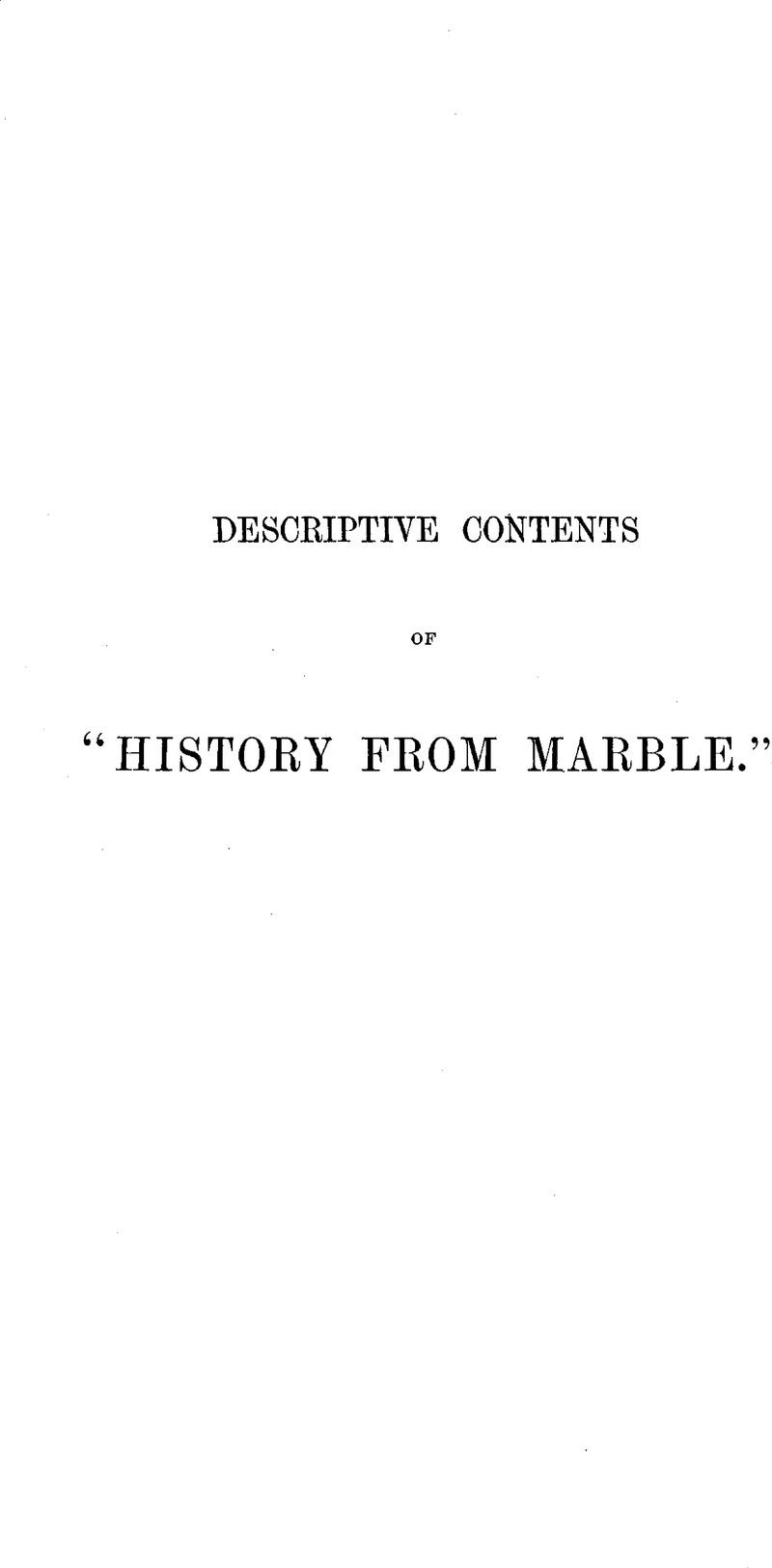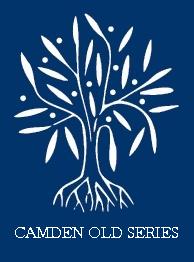No CrossRef data available.
Article contents
Descriptive Contents of “History From Marble”
Published online by Cambridge University Press: 23 February 2010
Abstract

- Type
- History from Marble
- Information
- Camden Old Series , Volume 94: History from Marble. Compiled in the Reign of Charles II. By Thomas Dingley, Gent , September 1867 , pp. 49 - 92
- Copyright
- Copyright © Royal Historical Society 1867
References
page 50 note 1 The History and Antiquities of the Cathedral-Church of Salisbury, and the Abbey-Church of Bath, 1719, 8vo. (subsequently quoted as Mawlinson.)
page 51 note 1 “This last coat is over ye daughter of Dr. Pierce,” i.e. Bobert Peirce, M.D. Oxf. 1661, Fellow of the B. Coll. Phys. 1689, author of Bath Memoirs, 1697; a very curious work from the multitude of cases it contains relating to the higher ranks of society. He died at Bath in June 1710. Munk's Boll of the Boyal College of Physicians, i. 441.
page 52 note 1 Dingley writes the name “Billet,” and so in the inscription he gives. It was probably so commonly pronounced, and thus agrees with the rebus in the east window of the abbey church, put up by the benefactor, which is full of heraldic billets. Bellott's arms were, Argent, on a chief gules three cinquefoils of the first. Crest, an arm couped at the elbow and erect in armour proper, holding in the gauntlet a baton or, tipped at each end sable (alluding to his office of steward to Lord Burghley). These have lately been placed in carving on the roof of the abbey church.
page 53 note 1 In Monumental Brasses of Wilts, p. 463, this is erroneously blazoned, and assigned to Beauchamp.
page 54 note 1 Dingley has here incorrectly drawn Baynton instead of St. Amand, as it remains in the original shield.
page 55 note 1 Edward Hungerford, esq. of Farley Hungerford, who died 1681, married Lady Alethea Compton, only daughter of the first marriage of James Earl of Northampton: she died 1676. As her father had sons by his second marriage, the coat of Compton was not correctly placed on an escucheon of pretence: see Addenda, hereafter.
page 55 note 2 Susan Pretyman was the wife of Edward Hungerford, of Cadenham. He died in 1667, and she died at Calne, 1705. (See Hungerfordiana, pp. 20 and 22.)
page 56 note 1 Her Majesty's visit was in the year 1663, as appears by the following passage of Bath Memoirs, by Eobert Peirce, Dr. in Physick, 1697, p. 257: “Amongst others that greatly encouraged the drinking of them [the Bath waters] was Sir Alexander Prayser, chief Physitian to King Charles the II. He waiting upon His Majesty and Queen Katherine, in 63 (whose Court was then at my House, the Abby, in Bath).” Pepys, on the 15th June, 1668: “Looked into the Baths, and find the King's and Queen's full of a mixed sort of good and bad, and the Cross only almost for gentry.” At the present day it is a cheap public bath.
page 56 note 3 The widow of “the learned, eloquent, and pious Mr. Jonathan Gyare, late minister of Chippenham,” died in 1688, and was buried in Bath Abbey. She was Elizabeth daughter of John Williams, Esq. of Herringstone, co. Dorset, by Eleanor, one of the daughters and coheirs of Richard Philips, Esq. of Montacute, co. Somerset. Her long epitaph will be found in Rawlinson's Antiquities of Bath Abbey, at p. 188.
page 57 note 1 There are various works on the Eoman antiquities of Bath, from Dr. Thomas Guidott, the contemporary of Dingley, to the present day, including the magnificent work of Mr. Samuel Lysons, Rellquiæ Romanæ (Part II.): but the latest and roost. comprehensive memoir on this subject (to which references are made on the present occasion) bears this title: AQIXS: Sous, or Notices of Roman Bath; by the Rev. H. M. SCARTH, M.A. Prebendary of Wells and Rector of Bathwick, &c. &c. With fifty-two illustrations by C. S. Beckett, 1864, 4to.
page 57 note 2 “Bladudus Magus, that wyse Magicyan,” who discovered, if he did not actually contrive, the hot springs, as tells Dr. Jones, in The Bathes of Bathes Ayde, 1572. “According to Stukeley this statue formally occupied a niche in the North Gate above the arch, where, in 1363, it represented King Edward III. It was taken down from thence, and somewhat altered by a common mason to represent King Bladud, and then transferred to the King's Bath.” Falconer's Baths of Bath, p. 7.
page 58 note 1 “Above the stone chair is a mural tablet recording the gift of an ornamental balustrade for the bath by Sir Francis Stonor in 1697 [but Guidott gives the date 1624, and this is now confirmed by Dingley], the ornamental portion of which between the balusters has been lately restored, and a balustrade of the same pattern placed on the eastern side of the bath.” Falconer, 1867.
page 59 note 1 Mary, daughter of Thomas Fereby, Vicar of Bishop's Cannings. See Aubrey's Nat. History of N. Wilts, p. 109, and Wilts. Collections, Aubrey and Jackson, p. 279.
page 65 note 1 Sir Thomas Eoe was elected to parliament as burgess for Cirencester in 1620, the year before he went to Turkey: see his memoirs in the biographical dictionaries. His portrait is engraved by Vertue, 1741, and in Ogborne's History of Essex, 4to. p. 93.
page 66 note 1 “The History and Antiquities of the Colleges and Halls in the University of Oxford. By Antony Wood, M.A. With a Continuation to the Present Time. By the Editor, John Gutch, M.A. Chaplain of All Souls' College. 1786.” 4to. It contains all the epitaphs and all the heraldry then existing.
page 66 note 2 He has nearly rubbed out the v, but every mark in the MS. whatever its shade of colour, is necessarily of a uniform tint in the ink used for printing.
page 68 note 1 Speercles in Peshall.
page 69 note 1 The old church of Allhallows (now usually called All Saints) was removed shortly after the accidental fall of its spire in 1699, and rebuilt in 1705–8 from the designs of Henry Aldrich, CD. Dean of Christchnrch. The ancient monuments described by Anthony à Wood are given in Sir John Peshall's Ancient and Present State of Oxford, 1773, Appendix, p. 6: but some of those now noticed by Dingley are not there mentioned.
page 70 note 1 An account of the discovery of Bishop Trilleck's coffin, with an engraving of the head of his crozier, is given in “A short Description of a Portable Shrine” (Saint Ethelbert's), by the Rev. Thomas Eussell, M.A. 1830. 8vo. The crozier is also engraved in The Antiquarian and Topographical Cabinet.
page 73 note 1 The shield above Fayster's head is of his arms, Gules, three fleurs de lis or, as they appeared in the third window on the south side of the nave. (Duncumb, p. 543.) On the shield between the heads of the mayor and his wife was a bend and in sinister quarter a lion rampant. (Ibid. p. 544.)
page 75 note 1 This name is misprinted Studder in Price's Leominster, p. 106, and in Townsend's Leominster, p. 234. The biography of Mr. Tombes will be found in the latter work, p. 116.
page 75 note 2 There is a pedigree of King, of Black Hall in King's Pion, in the Visitation of Herefordshire, 1683. (Coll. of Anns, K. 6, f. 71.)
page 79 note 1 In Duneumb's Herefordshire, p. 520; in Willis's Cathedrals; and in the European Magazine 1792, from a drawing made in 1724. It is shewn in ruins in Hearne and Byrne's Views.
page 81 note 1 Gilbert de Swinfield was nephew to the Bishop of that name, and Chancellor of Hereford. See various references to him in the index to the Household Roll of Bishop Swinfield, printed for the Camden Society.
page 85 note 1 It is very probable that this young lady was a sister of the Mary Thompson whose epitaph at Tewkesbury will be seen in p. cccxlvii. and therefore a grand-daughter of Dingley's friend Theophilus Alye.
page 88 note 1 This has long since disappeared. Newport has since been a seat of the Foleys, and has lately been rebuilt a second time, by Mr. Gibson Watt, grandson of the great engineer.
page 88 note 2 There is a pedigree of Pember in the Herefordshire Visitation of 1683 (Coll. Arm. K. 6). Devereux Pember was of Newport and Bollinghill. His grandson John of Tuthill, co. Hereford, was ætat. 49, 1683; Thomas the Fellow of All Souls' graduated B.A. 1676, M.A. 1680, and it therefore seems uncertain whether he was Thomas younger brother of John, and fifth son of the Kev. John Pember, Vicar of Bodenham, or a more distant relation.
page 88 note 3 The ancient arms of Hereford had been Gules, three lions passant argent. The augmentation of the bordure with saltires was intended to allude to its siege by the Scots, from which it was relieved by the arrival of the King in person in Sept. 1645.
page 89 note 1 This fine example of timber architecture was erected in 1618–20. It is attributed to John Abell, the master builder of that century, together with the principal edifices of the same character still existing in the county—and how far his claims justly extend it would be interesting to ascertain. John Abell died in 1691, aged 97, and has a monument (said to hare been carved by himself) in the church-yard of Sarnesneld, with his kneeling eifigies and those of two wives, and a poetical epitaph, in wh.ich he is styled an “architect.” He was appointed “one of His Majesty's carpenters” during the defence of Hereford at the siege of 1643.
page 90 note 1 See many varieties of mediaeval verses, conveying these sentiments, collected in an article in the Gentleman's Magazine for October 1833, p. 302.
page 90 note 2 The word which Dingley has written “remit” (and which has been misread in various ways by others) is liepist in the original.
page 90 note 3 See Duncumb's History of Herefordshire, vol. i. pp. 405–409. Sir Thomas Coningsby had served in the wars of Prance, and was the writer of the letters which, collected in a narrative form, have been printed for the Camden Society in the first volume of their Miscellany, under the title of A Journal of the Siege of Rouen, 1591. He acted during that campaign as muster-master of the English army commanded by the Earl of Essex, and was one of the twenty-four knights made by the Earl on the 8th October. His biography is further traced in the Introduction to his Journal at p. 5.
page 91 note 1 Sir Thomas Coningsby was buried in the church of Hope, May 30, 1652. (Price's History of Leominster, p. 169).
page 92 note 1 Daughter of John Best, D.D. Prebendary of Hereford; she died s.p. The Vicar of Bodenham married, secondly, Mary, daughter of Thomas Ball, of Sponne, and had issue fire sons, 1. John, of Tuthill, co. Hereford, ætat. 49 in 1683; 2. Devereux; 3. Gregory; 4. Robert; 5. Thomas. (Visitation of Herefordshire, 1683, in Coll. Arm.)


